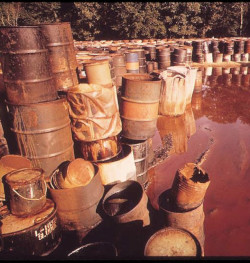Drum Excavation and Handling
The safety practices below should also be followed during excavation and handling activities to protect workers.
- Where buried drums are suspected, conduct a geophysical survey before using any construction equipment to minimize the possibility of rupture.
- Use a drum grappler where possible to minimize contact with drum. If a grappler is not available, pump or overpack drums of poor integrity before excavation.
- Ground equipment before transferring wastes to new drums.
- Use non-sparking hand tools and non-sparking bucket teeth on excavation equipment, and use plexiglass shields on vehicle cabs.
- Where slings, yokes, or other accessories must be used, workers should back away from the work area after attaching the accessory and before the drum is lifted.
- Critically swollen drums should not be handled until pressure can be relieved. Use bars that fit over the teeth of excavation buckets to prevent drum puncture.
- Where ionizing levels of radiation are detected, the Site Health and Safety Officer should be contacted; generally, the drum should be over-packed and isolated promptly.
- Where explosive or shock-sensitive material is suspected, every effort should be made to handle the drum remotely. Gas cylinders should not be dragged during handling.
- Use direct-reading air monitoring equipment when close to drums to detect any hot spots.
Knowledge Check Choose the best answer for the question.
3-5. Which action should be taken before transferring wastes to a new drum?
You forgot to answer the question!

